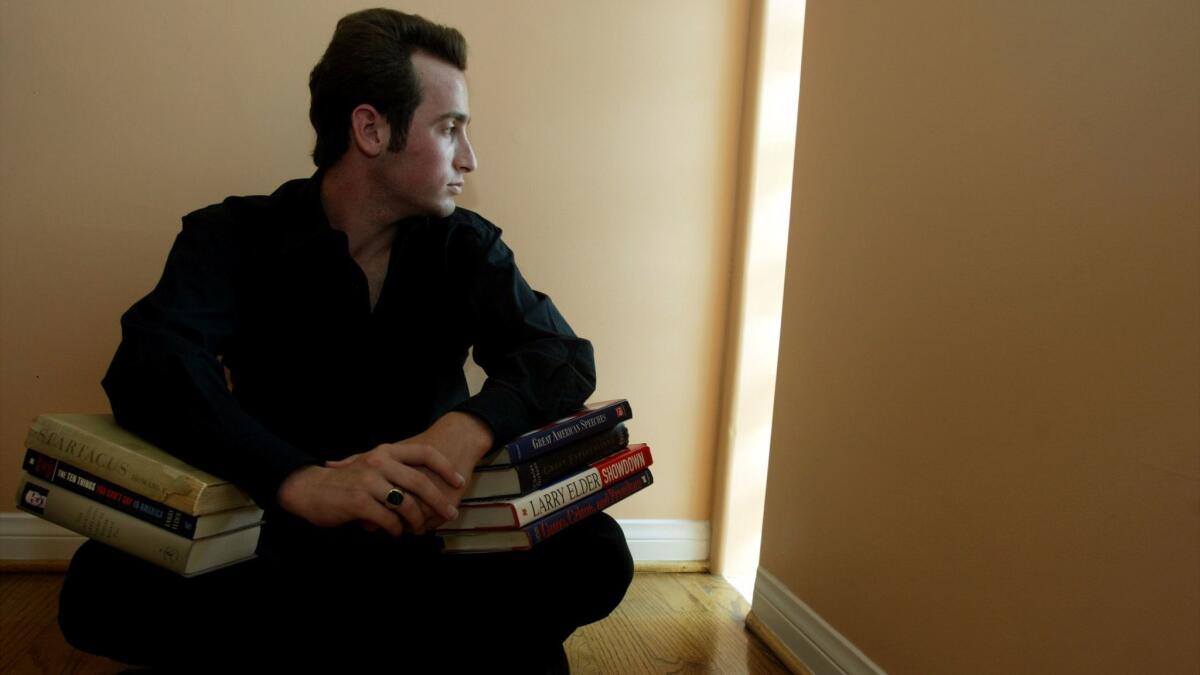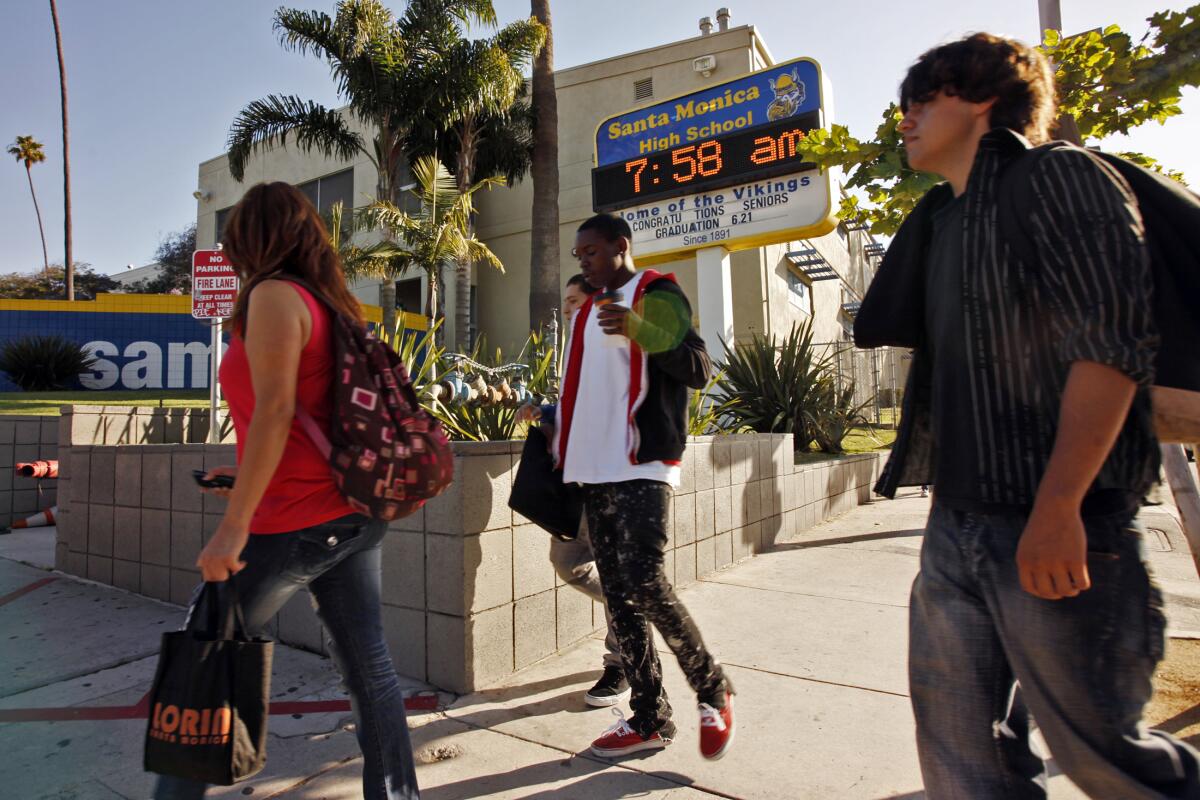On a palm tree-lined bluff overlooking the Pacific Ocean, thousands of people rallied against the Trump administration in one of many “No Kings Day” protests around the country last month.
Here in Santa Monica, the well-heeled and beachy protesters also had a localized message: America, we’re sorry.
“Santa Monica apologies for Stephen Miller,” a bearded man in a straw hat proclaimed via hand-scrawled poster board.
“Stephen Miller, who raised you?” another protester inquired in purple puff paint. Others paired the White House deputy chief of staff’s name with expletives.
Amid the false accusations and acrid clashes of President Trump’s inner circle, few acolytes have survived longer than Miller.
The 39-year-old has remained essential through Trump’s second term, piloting an immigration platform that has sowed fear across wide swaths of the country — nowhere more so than greater Los Angeles, where federal agents have mounted a relentless assault on immigrants, sweeping up thousands in deportation raids.
In the long shadow of his policies, local and national observers alike are paying renewed attention to Miller’s upbringing in the famously liberal enclave once dubbed “the People’s Republic of Santa Monica.”
“I think people are sad that the words ‘Santa Monica’ and ‘Stephen Miller’ are synonymous, because no one wants that connection,” said Santa Monica Mayor Lana Negrete.
Though often seen as a liberal enclave, Santa Monica is also where conservative strategist Stephen Miller grew up.
(Genaro Molina / Los Angeles Times)
How did the same 8.3-square-mile city that helped pioneer curbside recycling and strict rent control laws produce a man responsible for Trump’s most draconian policies?
Some are also questioning whether the administration’s focus on Los Angeles is a form of revenge on Miller’s spurned hometown.
When rumors of ICE agents seizing nannies at a Santa Monica park frantically flashed across social networks, Justin Gordon, who went to Hebrew school and high school with Miller, immediately thought his classmate must have personally directed the raid on their local park.
The reports proved spurious, but Gordon still saw an emotional truth.
“In the back of my mind, I’ve always thought, ‘This is Stephen Miller getting back at the city of Los Angeles,’ ” Gordon said.
In the eight years since Miller rose to fame and became an outsized antagonist on the American left, his Santa Monica villain origin story has been exhaustively documented, picked over and reanalyzed.
At the far edge of the American west, a brash adolescent came of age in a coastal community where the establishment prided itself on being antiestablishment. What choice would a young reactionary iconoclast have but to veer right?
Santa Monica was a town in flux when Miller was in high school at the turn of the millennium: a Berkeley meets Beverly Hills where haughty affluence was rapidly eclipsing the Birkenstocks and counterculture bumper stickers. It was also a tale of two cities, with moguls and the upper middle class north of Montana, and pockets of poverty and gang violence in the southern end of town.
Nowhere was this more evident than at Santa Monica High School, where the academics were nationally renowned, the student body resembled a United Colors of Benetton ad and a ’90s strain of “Free to Be … You and Me” liberalism reigned supreme.
The parade of cultural affinity clubs, diversity events and policies that sought to make the school more equitable nauseated Miller.
And the teenage provocateur made no secret of that revulsion, loudly belittling his fellow students. His bitter shtick offered a prescient preview of the grievance politics that would fuel his future boss into power.
Miller has said his years in high school were the hardest of his life, filled with pushback for his “vitriolic viewpoints,” according to Jean Guerrero, a former Times columnist and author of the 2020 Miller biography “Hatemonger.”
“And for whatever reason, he’s had this grievance about that ever since, and he’s been trying through various means, to have what I see as a form of revenge on the communities that rejected him in Los Angeles,” Guerrero said.

Stephen Miller when he was a student at Santa Monica High.
(Francine Orr / Los Angeles Times)
Through the White House, Miller did not respond to a request for comment. But anecdotes of Miller’s trollish high school antics have been exhaustively chronicled in the media.
There was the fight to restore the recitation of the Pledge of Allegiance on his bleeding heart campus. His frequent railing against “rampant political correctness,” multiculturalism and the perceived failings of his Latino classmates. Allegedly dumping his middle school best friend for being Latino.
Perhaps most infamous is a campaign speech, seared into the brains of thousands of Samohi classmates, in which he seemingly absolved students of their responsibility to clean up after themselves.
“I will say and I will do things that no one else in their right mind would say or do,” Miller told the crowd, according to a video obtained by Univision. “Am I the only one who is sick and tired of being told to pick up our trash when we have plenty of janitors who are paid to do it for us?”
Students jeered and booed as Miller was escorted off the stage, according to several attendees. He lost that student government election.
“The only compliment I think I’ve ever come up with for Stephen is that there are plenty of conservatives and far-right wing conspiracy theorists and hate mongers that spout what he spouted from behind a computer screen. I have not in my life before or after seen someone do it in an amphitheater full of their high school colleagues,” said Miller’s classmate Kesha Ram Hinsdale, now majority leader of the Vermont state Senate.
Santa Monica High was a hothouse of political engagement, where students — the children of entertainment executives, bankers and lawyers, as well as nannies, day laborers and wait staff — were finding their footing as activists.

Students arrive for a summer school session at Santa Monica High School in 2011.
(Al Seib / Los Angeles Times)
They had watched Proposition 187 pass in their early childhoods, stoking divisions and energizing a wave of Latino activists. (The 1994 ballot measure, which aimed to block undocumented immigrants from accessing public education and other state services, was ultimately blocked by the courts.)
They marched with labor leader Dolores Huerta in support of workers at a neighborhood hotel and protested against the growing threat of war in Iraq.
Despite the kumbaya vibes, Santa Monica High was hardly a post-racial utopia. Students often self-segregated, and the school’s academic sheen was riven by racial division.
Puckish, clad in a suit and preternaturally confident, a teenage Miller was a regular presence at school board meetings. He argued for an English-only school district, decried the board’s focus on equity and generally sought to puncture progressive ideals and push buttons.
“We all knew who he was, and knew him by name,” said Rep. Julia Brownley (D-Westlake Village), a Santa Monica-Malibu school board member from 1994 to 2006.
Miller was raised by Jewish Democrats several generations removed from their own asylum-seeking immigrant story. He enjoyed a comfortable childhood north of Montana, until the family real estate company faltered in the early ’90s and the Millers eventually relocated to a smaller rental on Santa Monica’s shabbier southern end.
Reactionary conservatism didn’t become a defining aspect of Miller’s persona until he started high school, according to Jason Islas, one of his best friends in middle school.
The friendship dissolved the summer before they started at Samohi when, in Islas’ telling, Miller called and announced that they would no longer be hanging out.
Miller delivered the news brusquely, citing Islas’ lack of confidence, his teenage acne and his Latino heritage in a “businesslike tone.”
“It was pretty cruel, even for a teenager,” Islas recalled.
Through a spokesperson, Miller denied this account in 2017. But his derision toward Latino classmates is well-documented — in his own words.
“There are usually very few, if any, Hispanic students in my honors classes, despite the large number of Hispanic students that attend our school,” a 16-year-old Miller wrote in a 2002 letter to a local paper.
The letter denounced the fact that school announcements were made in English and Spanish, “preventing Spanish speakers from standing on their own” and making “a mockery of the American ideal of personal accomplishment.”
Captivated by right-wing radio hosts like Rush Limbaugh and Larry Elder, Miller was a frequent guest on Elder’s show as a teenager, complaining about other perceived liberal excesses of his high school.
After graduating in 2003, Miller went to Duke University before landing on Capitol Hill, where he threaded his way up the far-right thicket with then-Rep. Michele Bachmann of Minnesota and then-Sen. Jeff Sessions of Alabama.
Many of his grievance-fueled Samohi talking points found their way into the first Trump campaign, where Miller had a mind-meld of sorts with the future leader of the free world.
In Trump’s second term, Miller has moved faster and gone further than during the first term, when he advocated unsuccessfully for using the military to push immigration enforcement. This time around, the administration has deployed troops to an American city in a staggering show of force, with masked agents raiding businesses and public spaces.
Ari Rosmarin, a civil rights lawyer who also attended Santa Monica High, said Miller has always had a keen eye for picking fights that would generate maximum hate, outrage and attention. It’s the through line connecting his youthful theatrics with the current assault on Los Angeles, Rosmarin said.
“He knows L.A. — knows that it’s home to both a super, super diverse and beautiful immigrant community, but also home to tons of media, cultural capital, financial capital,” Rosmarin said. “I think in those ways, it’s a particularly attractive site for a battle if your goal is not just a policy outcome, but a political and cultural attack.”
This story originally appeared on LA Times

